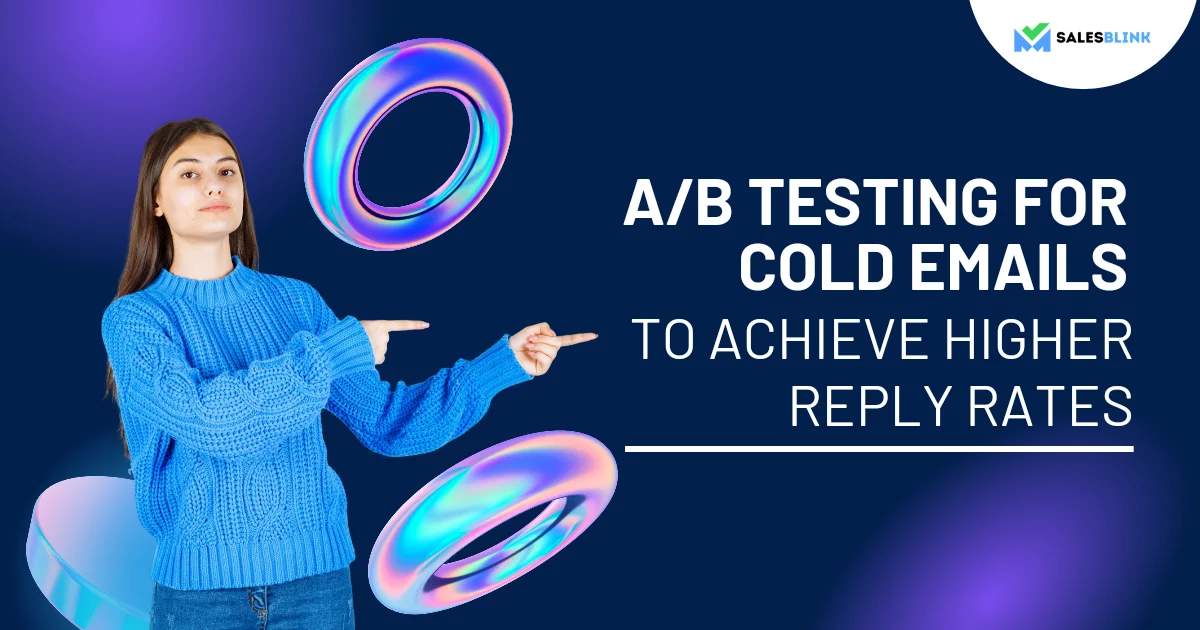A/B Testing for Cold Emails to Achieve Higher Response Rates
With an ROI of 3800%, cold emailing is hands down the best way to acquire prospects. However, it is your approach that determines the effectiveness of your email campaign, isn’t it? Are you wondering what that approach is? Well, it is A/B testing your cold emails.
Using A/B testing the right way will definitely help you find out which campaign is performing better. That is exactly what our client Bob did! He surprisingly saw a 30% jump in open rates with A/B testing and a couple of our inputs. This in turn helped him enhance his ROI. I bet you want to achieve similar results too!
Let’s start with the basics of A/B testing for cold emails, and then move on to how you should do it, the types of A/B tests, and the best practices to follow.
Table of Contents
- What Is A/B Testing For Cold Emails?
- Why Do You Need To A/B Test Email Campaigns?
- How To Do A/B Testing For Cold Email Campaigns?
- Types Of A/B Tests For Cold Email Campaigns
- What Should You A/B Test In Your Cold Emails?
- Subject Line A/B Testing Ideas
- Email Copy A/B Testing Ideas
- CTA A/B Testing Ideas
- Email Signature A/B Testing Ideas
- Post-Script A/B Test
- A/B Testing Email Sending Schedule
- Is It Essential To A/B Test Every Element Of A Cold Email?
- Best Practices For Email A/B Testing
- Tools To Make Split Testing Easier
- FAQs
What Is A/B Testing for Cold Emails?
A/B testing or split testing helps find out which of two email campaign options fetch higher opens and clicks. With A/B testing, you create two versions of the same campaign and send the emails to a small fraction of recipients. Half of the test group receives version A of the campaign, while the other half receives version B. The result of the campaign decides which version is the best. You can then send the best-performing version to the remaining prospects on your list.
In short, you test two different versions of the email campaign on a small group of prospects and send the best-performing version to the remaining prospects on your list.
Why Do You Need To A/B Test Email Campaigns?
Split testing takes center stage when you talk of outreach strategies. The main reasons to do split testing or A/B Testing for cold emails are the following,
1. You make decisions based on the data instead of relying on intuition and guesswork.
2. Find out when the campaign is performing well and when it is not based on actual prospect response.
3. It is possible to look at email metrics such as email click-through rates and opens to create email campaigns that engage prospects better and help you close more deals.
4. You can make more recipients open your email, click on the links, and turn into paying customers.
5. It is easy to test campaigns before actually running them for all the recipients on your list.
6. A/B testing prevents making expensive and tedious changes that are not productive at a later stage.
That was about the benefits of the A/B testing cold email campaigns. Let’s move further ahead to see how to do A/B testing for cold emails.
How To Do A/B Testing For Cold Email Campaigns?
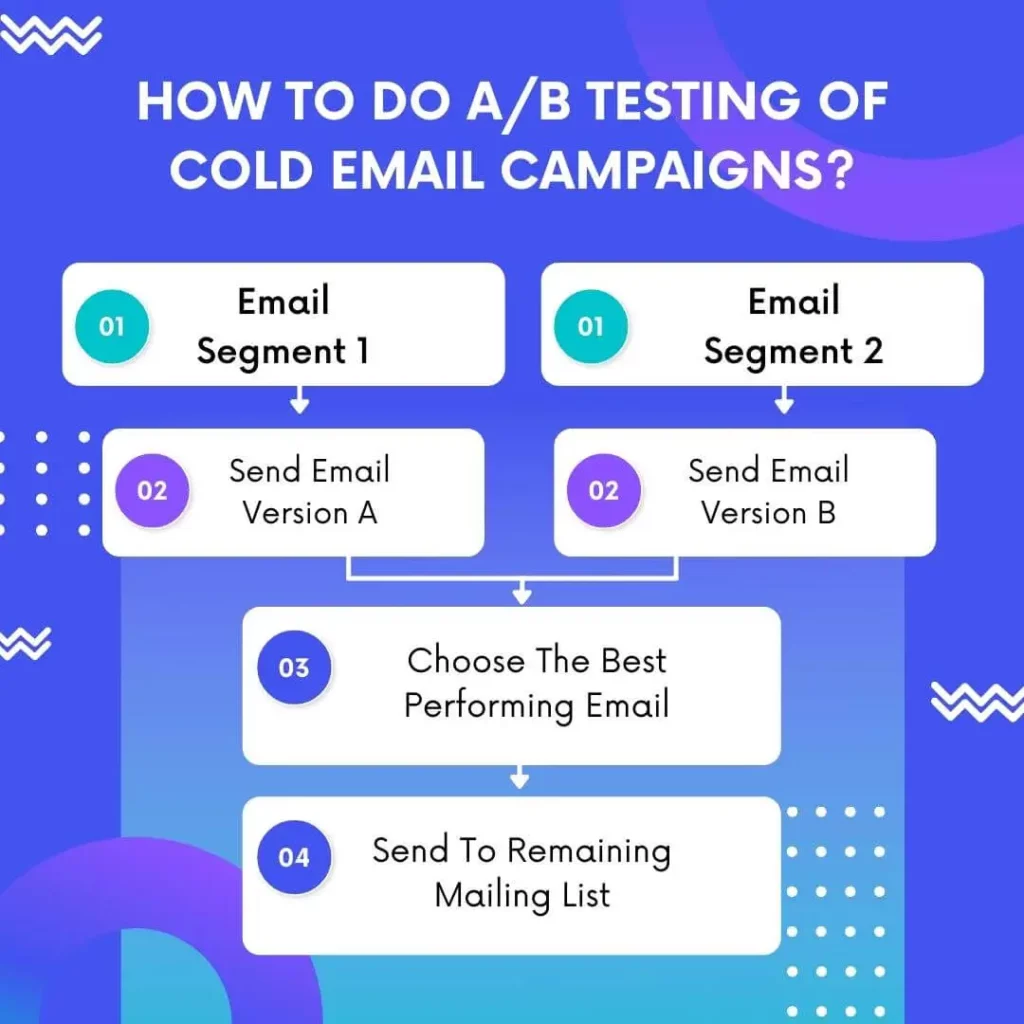
You can divide the list of prospects you have to reach out to into two parts. The two groups have to be homogeneous, i.e. similar to one another based on quantity and quality.
Consider that you are a company offering automated web designing tools, and there are web developers on your contact list. If you want to use the email marketing strategy to reach out to them and perform A/B testing your our subject line, you have to do the following,
1. Pick 100 contacts off your list and divide them into two groups of 50 each.
2. Create the two versions email subject line while keeping the email copy the same for both the groups
Version 1 of the subject line: Want to automate web designing and save time?
Version 2 of the subject line: A question for you for your project with Pepsico
The next step is to send the emails with version 1 of the subject line to the first list of 50 prospects and version 2 to the other 50.
Compare both versions’ open rates and reply rates and find out which one fetches you better results. The subject line that fares better is what you should choose for the rest of the prospects on your mailing list. If the results are not satisfactory, you can continue to A/B test the subject line of the email or split test some other element of the email.
Isn’t that an easy way to ensure a good outcome?
Types Of A/B Tests For Cold Email Campaigns
A/B testing in email marketing is basically of two types,
1. Classic A/B Testing
The classic A/B testing involves comparing different versions of the same email element. For instance, the test can check which version of CTA (call-to-action) in the email gets more clicks.
2. MVT or Multivariate A/B Testing
This test checks email versions with more than one email element changed. For example, you can find which subject line, greeting, and CTA respond better in one test without comparing the elements one at a time.
What Should You A/B Test In Your Cold Emails?
To find out what elements of your emails should undergo the A/B test, ask yourself about your goal. Do you want to increase the open rates of the email or want the recipients to reply positively to your email? Let’s take a look at each of them,
If you want to improve open rates

1. Test the email subject line
You are aware that recipients decide whether they should open your email or not based on the email subject line. No matter how good your email copy is, the subject line decides its fate. Try making it the most striking part of your email. Consider personalizing to get higher open and click rates.
2. Make the most of preview text
Apart from the email subject line, the introduction of your cold email also impacts the reader when they glance at their inbox. Email service providers display the preview text under the subject line to let the recipient know what is in the email body. Hence, make sure you leverage this feature.
If you want to get more replies
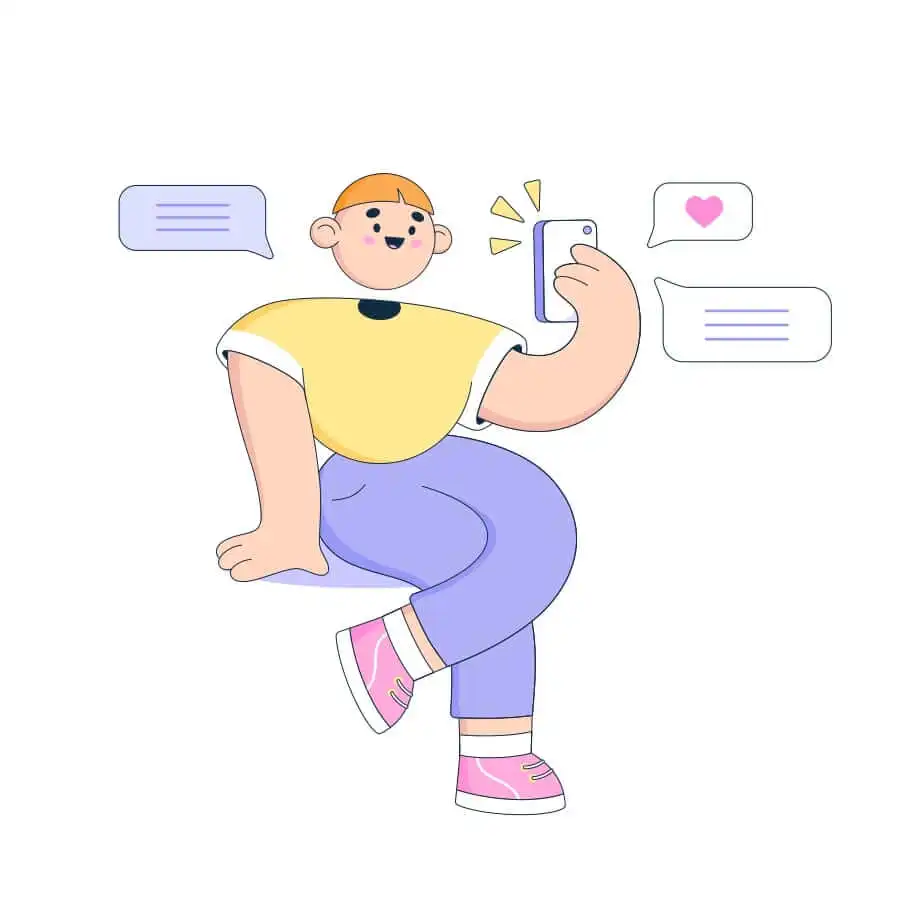
Your campaign will not be successful if the prospects open your email and choose not to reply. The reason can be the inability of the mail copy to grab the attention of the prospect. Since they opened it, the subject line may be catchy, but the body of the email failed to shine. Here’s what may have gone wrong,
1. Generic email body
You wrote too much about your company and product, or the email looked too generic to the recipient.
2. Unclear CTA
There’s a lack of clarity in the CTA (call-to-action), due to which prospects didn’t know what action to take next.
To identify why people didn’t reply, you can perform A/B testing of the different email copy versions and find out which one is getting better results.
Let’s take a deeper look at A/B testing the different elements of a cold email.
Subject Line A/B Testing Ideas
There are a few guidelines that you should try to follow while crafting cold email subject lines. Firstly, take a look at the email subject line testing ideas if you want to know what works the best.
1. Subject line length
It is better to have shorter catchy email subject lines for your cold emails, but there are times when longer ones too fetch great results. There is ongoing research in this regard and we hope to find a conclusive answer.
2. Using lowercase for subject lines
Some people like to use the title case in cold email subject lines, i.e. they capitalize the first letter of each word. However, this doesn’t work every time. Sales experts found that such a format doesn’t get good results in comparison to subject lines with the sentence case. Try to A/B test for yourself and see what your target audience prefers.
3. Using ‘you’ vs not using ‘you’
You can add a personal touch to your subject lines by using a ‘you’ in them. Usually, email open rates and click-through rates are higher when the subject line has ‘you’ instead of one that doesn’t. You can split test and find out what works for your audience.
4. Personalization with prospect’s name or name of their company
Have two versions of the email. One with the prospect’s first name/company name in the subject line and the other version without it. Do note that you can take the help of automated cold outreach tools to personalize your cold email subject lines at scale.
5. Using emojis
As the younger generation is getting into the B2B world and they have a fancy for emojis, you can consider using them. Create versions of email subject lines with and without them and perform split tests. Just bear in mind that you are targeting the relevant industry while doing so.
6. Asking a question
When someone asks a question, you will have an urge to answer it. Use this tactic in your cold email subject line to intrigue the prospects and make them open the message.
7. Arouse curiosity
Ideally what is in your email body should be in your subject line. You shouldn’t click-bait or else the recipient will lose trust in you. However, you are free to make the prospect a little curious and play around with words. You can use statistics too but test it to know for sure.
8. Using ‘re:’ in follow-up emails
You can test two versions of email subject lines with and without ‘re:’ and see how it fares. It is usually effective to have your subject line begin with it, but with the overuse of this tactic, the subject lines lose their charm. Nevertheless, try testing it.
So, that was about email subject line testing.
Email Copy A/B Testing Ideas
Now let’s move onto the A/B testing ideas for email copies of your cold email campaigns. You have to find out what works the best in getting a positive response from the prospect.
1. The greeting
The greeting is the first thing that strikes the eyes after the subject line. You can set the tone for the email with it. A “Hey” or “Hi” makes it seem less formal, a “Hello” makes it formal, and using just the name means serious business. Test the different greetings to see what is the best one.
2. Intro or no intro in the first line
Sales professionals avoid using the intro in the first line as some email clients let the recipient see it before opening the email. In addition to that, some recipients don’t even care about an introduction. You can find that out by performing a test.
Consider these two examples,
a. Hi{{First_Name}},
My name is Sarah John, and I have created a list of the latest trends in the {{industry_name}}.
b. Hi{{First_Name}},
Do you want to take a look at the latest trends in {{industry_name}}? I have come up with a list of the current trends that can help your business…
You can test the two and find what the recipients find better.
3. Pointing out mistakes
In your email copy, you can point out the commonly-made mistakes and the ones that the prospect is making to establish your knowledge of your niche. It can be a great conversation starter. Test this and find out if there are enough takers.
4. Placing a link to a resource vs asking before sending
It is common to place a link in an email, but in a B2B cold email, you have to focus on building a relationship with the prospect. You can ask the prospect whether they want the free resource and get their nod before sending it. It is an excellent way of building a relationship, and you can test it.
5. Use of images, videos, and Gifs
Placing visuals is a great idea, but you have to keep them relevant. Images, videos, and gifs can increase engagement, but they may or may not work all the time. You can test them for their effectiveness.
6. Numbered lists or bullet points
To convince the prospect to take the next step, you have to present your points in an appealing manner, and you can number them or use bullets to emphasize them. Perform a test it to see how it works.
7. Formal or personal tone
It is good to add a personal touch at times, but there are times when being more professional will give you a better outcome. You have to see who your target audience is before you can decide the tone of the email. You can test it and find out which one will be more suitable.
8. Customization vs personalization
Test by customizing emails heavily for a small group while personalizing it for another. You can choose to send personalized initial emails, and when the prospects open the email or click on a link in it, you can hyper-personalize the follow-up emails. Doing so will save you from the effort of hyper-personalizing every email. You can go ahead and research them in detail, and it won’t be a waste of time as they seem to have some interest in your solution.
CTA A/B Testing Ideas
You must test the CTA, which is the action you want the prospects to take after reading your email. It is essential to be reasonable with what your CTA asks for. The prospect is less likely to go out of the way for you in the initial correspondence stage through cold email campaigns.
Here are some of the CTA variations to the A/B test,
1. Placing the CTA at the starting of the email vs putting it at the end of the email.
2. Formatting text vs using plain text.
3. Requesting to meet at a certain time vs giving a free hand to prospects to choose the time.
Email Signature A/B Testing Ideas
You have to give importance to your email signature as it is your e-business card. With its help, your prospects can know more about your business and what your product or service is about. It would be best if you considered A/B testing them to find out what your target audience prefers.
1. Signature with image vs no image
You can have your image or your company logo on your email signature. There can also be a signature without any images. See what works the best.
2. Signature with social link vs without link
It is helpful to have social media links in some instances as they enable the prospect to look at your social media profiles. It largely depends on the industry. Perform an A/B test to find out what is a perfect match.
3. Full signature vs a short one
You can send your full email signature or choose to shorten it. Just remember that to comply with the CAN-SPAM Act, you have to provide a complete physical mail address, you can cut short the rest of the email signature. Split test and find out what the majority prefers.
Post-Script A/B Test
When there is a P.S. in cold sales emails, the recipient will read what you have mentioned there. That is why you have to test the content of this section of your email. P.S. has to be a part of your initial emails. However, it is up to you to make them a part of the email you send after the first email. Perform an A/B test to be certain.
A/B Testing Email Sending Schedule
When you send your email makes a lot of difference. Try A/B testing the email based on the days of the week you choose to send the email and the time of day. It is essential to keep the time zone in mind if you are sending emails to people from the other side of the globe.
Most often, your emails will get more open when you send them on Wednesday. Sending them on Sunday will get you more clicks. The best time to send an email is usually between 4 pm and 11 pm.
However, by A/B testing, you will be able to get a better idea of the days of the week and the hours of the day when there will be a better response from the recipients. Try testing mornings vs evenings, weekdays vs weekends to know what is the right timing for your prospect list.
Is It Essential To A/B Test Every Element Of A Cold Email?
You have to focus on some elements more than others, but there is no need to test each element of your cold email. It would be sufficient to test subject lines and CTA as they need more attention than other elements of your email. It is the subject line that gets the maximum number of tests.
Best Practices For Email A/B Testing
You can A/B test email campaigns more effectively by following a few best practices,
1. While split testing, you should only change one element of your cold email. If you happen to change more than one, you cannot call it a split test. However, if they want to speed up the process, you can try a few variations of one element but don’t go beyond four in one go.
2. Ensure that the figures you are testing are significant enough to make decisions based on the results.
3. You should compare the results of A/B testing when the conditions are the same. For instance, you cannot compare the open rates for an email you sent on Monday with that you sent on Saturday.
4. Pay attention to the data you get from split-testing. The whole aim is to make data-backed decisions and tweak your email marketing strategy.
Tools To Make Split Testing Easier
For performing A/B tests, you don’t need to invest in expensive systems. You can use the tools that your outreach or marketing platform offers to track metrics like open rates, click rates, etc. Automated cold outreach tools or cold email software help you out with measuring the performance of campaigns.
SalesBlink is one tool that enables A/B testing of emails. Let’s take a look at it.
First start building a sequence.
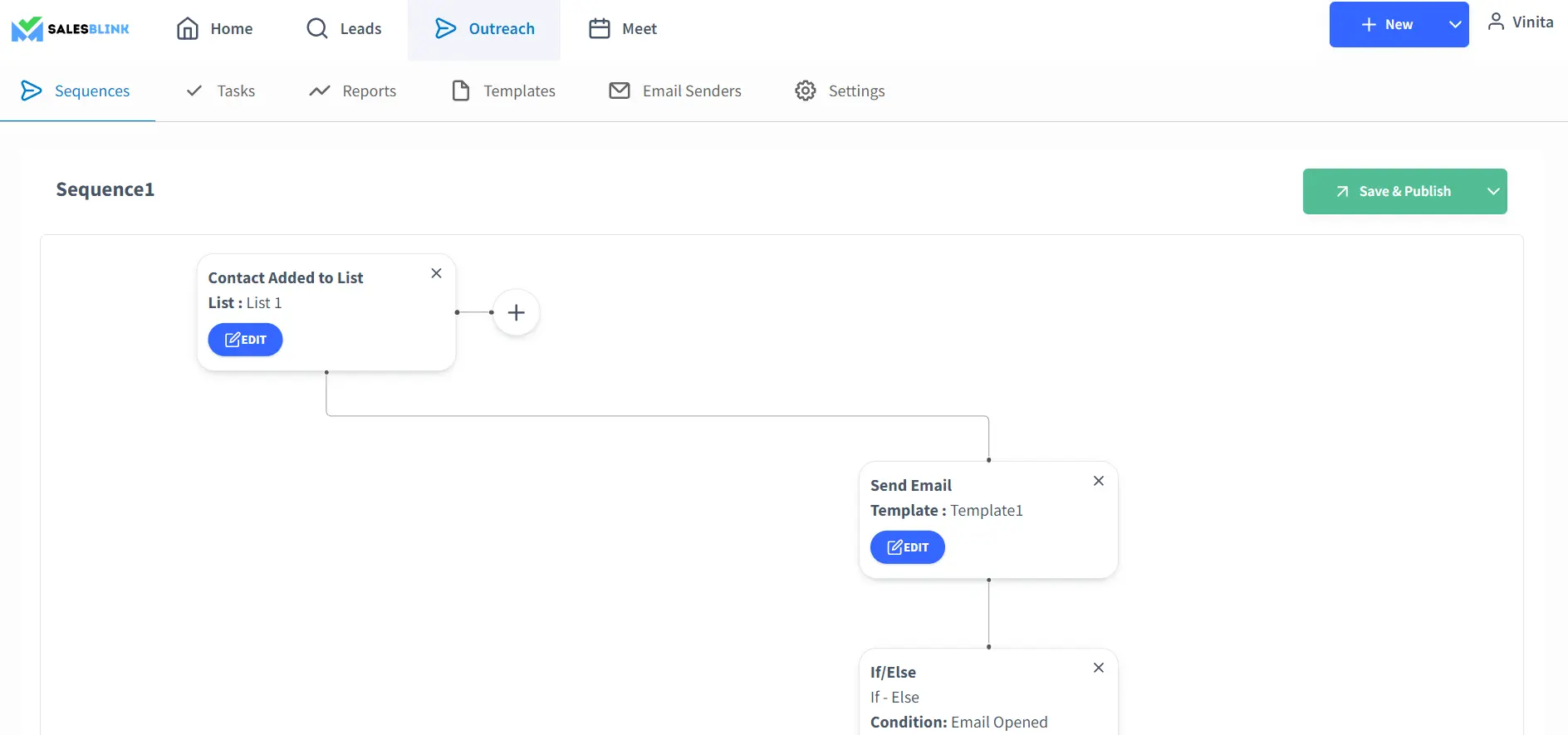
Then you can add blocks to the sequence by clicking on ‘+’. To perform A/B testing of an email, click on the condition – A/B Split as you can see below.
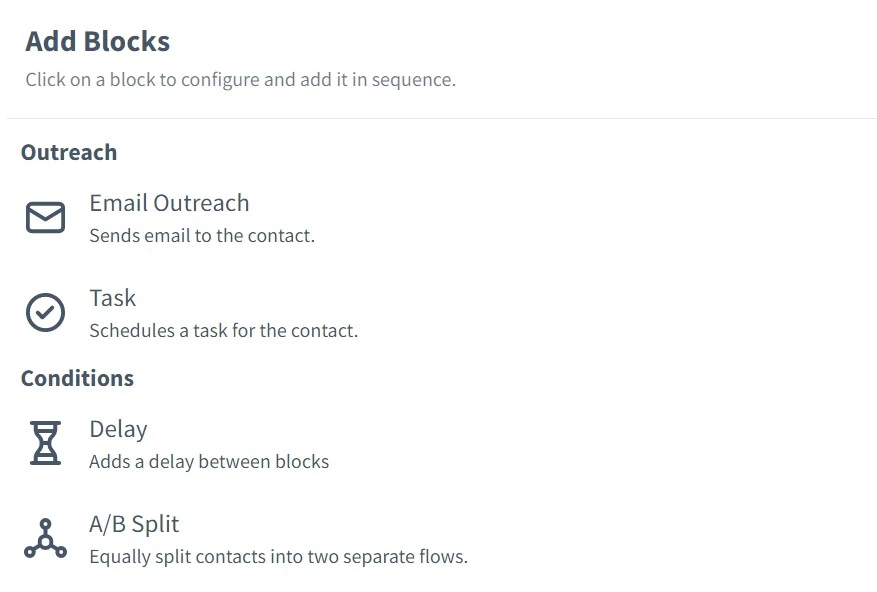
A/B split will divide the contacts in the sequence into two different flows. And you can check the performance of each before deciding which one to choose.
Even in the absence of gauging metrics, you can do A/B testing by collecting qualitative data and making decisions by speaking to customers after sending cold emails. You can ask recipients what went right for them in your email. It will help improve your campaign’s performance.
Get Ready To A/B Test Your Emails Like A Pro!
After learning about A/B testing for cold emails, you can make your email marketing campaigns more effective. Although our suggestions will help your business grow rapidly.
FAQs
There are 2 types of A/B testing: Classic A/B testing & Multivariate A/B testing. In the 1st one, you compare different versions of the same element, while in the 2nd one, there is a change in more than 1 email element.
You can decide which course of action to take based on responses from prospects and data. There is no guesswork involved. In the end, you increase open and click-throughs leading to more conversions.
You can use automated sales outreach tools to perform A/B testing. There are many like SalesBlink that help you A/B test emails before you run the campaign on full throttle to make the best of it.
